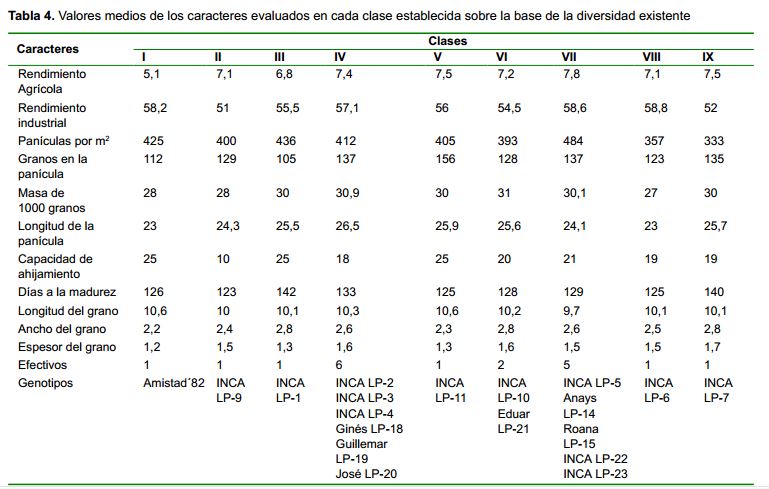Phenotypic diversity of Cuban rice cultivars obtained by INCA in the period 1984-2020
Main Article Content
Abstract
With the objective of evaluating the phenotypic diversity of Cuban rice cultivars obtained by INCA, supported by morphoagronomic characters and multivariate analysis techniques, this work was developed in Scientific and Technological Base Unit belonging to the National Agricultural Sciences Institute of Cuba. 30 qualitative and 23 quantitative characters were evaluated and data processed through a multiple correlation analysis and multivariate analysis of automatic classification (clusters). The results showed that 11 characters qualitative were homogeneous and 10 were distinctive of some cultivars, within them, the color of the ligule, the leaf blade, node, internode, subnodal ring, stigma, as well as, the position of the apex of the first leaf below the flag leaf, lemma, palea and leaf pubescence, and panicle exertion. There is a positive and significant correlation between yield and grains per panicle; also, between mesocotile and coleoptile length with industrial yield and tillering capacity, respectively. Variation ranges are appreciated in all the quantitative traits evaluated and although the cultivars obtained are genetically related, they differ phenotypically.
Article Details

This work is licensed under a Creative Commons Attribution-NonCommercial 4.0 International License.
Those authors who have publications with this journal accept the following terms of the License Attribution-NonCommercial 4.0 International (CC BY-NC 4.0):
You are free to:
- Share — copy and redistribute the material in any medium or format
- Adapt — remix, transform, and build upon the material
The licensor cannot revoke these freedoms as long as you follow the license terms.
Under the following terms:
- Attribution — You must give appropriate credit, provide a link to the license, and indicate if changes were made. You may do so in any reasonable manner, but not in any way that suggests the licensor endorses you or your use.
- NonCommercial — You may not use the material for commercial purposes.
- No additional restrictions — You may not apply legal terms or technological measures that legally restrict others from doing anything the license permits.
The journal is not responsible for the opinions and concepts expressed in the works, they are the sole responsibility of the authors. The Editor, with the assistance of the Editorial Committee, reserves the right to suggest or request advisable or necessary modifications. They are accepted to publish original scientific papers, research results of interest that have not been published or sent to another journal for the same purpose.
The mention of trademarks of equipment, instruments or specific materials is for identification purposes, and there is no promotional commitment in relation to them, neither by the authors nor by the publisher.
References
Haghshenas H, Soltani A, Malidarreh AG, Norouzi HA, Dastan S. Selecting the ideotype of improved rice cultivars using multiple regression and multivariate models. Archives of Agronomy and Soil Science. 2020;66(8):1134-53. doi:10.1080/03650340.2019.1658866
Debouck DG. ¿Es imparable la erosión de genes y de conocimientos tradicionales?[Internet] En: Conferencia invitada en la Asignatura Agrobiodiversidad II. Facultad de Ciencias Agrarias, Universidad Nacional de Colombia, Bogota, Colombia, distanceeducation. Alliance
Biodiversity-CIAT, 45sl [Internet]. 2020; Available from: http://cgspace.cgiar.org
Pérez H, Rodríguez I. Cultivos tropicales de importancia económica en Ecuador (arroz, yuca, caña de azúcar y maíz) Tomo I. Ediciones UTMACH, Universidad Técnica de Machala, Ecuador. 2018. 242p.
Mastretta-Yanes A, Bellon MR, Acevedo F, Burgeff C, Piñero D, Sarukhán J, et al. Un programa para México de conservación y uso de la diversidad genética de las plantas domesticadas y sus parientes silvestres. Revista fitotecnia mexicana. 2019;42(4):321-34.
Pérez-Almeida IB, Torres EA, Graterol LRA, Barona MAA. Diversidad genética entre cultivares de arroz de Venezuela con base a la estimación del coeficiente de parentesco y análisis con marcadores moleculares microsatélites (SSR). Interciencia. 2011;36(7):545-51.
Muhamad K, Ebana K, Fukuoka S, Okuno K. Genetic relationships among improved varieties of rice (Oryza sativa L.) in Indonesia over the last 60 years as revealed by morphological traits and DNA markers. Genetic Resources and Crop Evolution. 2017;64(4):701-15. doi:10.1007/s10722-016-0392-1
Hernández A, Pérez J, Bosch D, Castro N. Clasificación de los suelos de Cuba 2015, edit. Ediciones INCA, Mayabeque, Cuba, 2015. 93p.
González MC, Pérez N, Cristo E. Gines: primer mutante de arroz obtenido a partir de la irradiación con protones. Cultivos Tropicales. 2009;30(3):59-59.
Cristo Valdés E, González MC, Pérez León N. Eduar LP-21. Nuevo cultivar de arroz (Oryza sativa L.) obtenida por cultivo in vitro de antera, tolerante a los bajos suministros de agua. Cultivos Tropicales. 2015;36(número especial):134.
González MC. Uso de la variación somaclonal en elmejoramiento genético para la tolerancia a la salinidad en el cultivo del arroz (Oryza sativa L.). [Instituto Nacional de Ciencias Agrícolas]; 1998. 100 p.
MINAG. Modificaciones al Instructivo Técnico para elcultivo del arroz. Instituto de Investigaciones del Arroz La Habana; 2019. 30 p.
Franquet BJM, Borras-Pamies C. Variedades y mejora delarroz (Oryza sativa L.). Universitat Internacional de Catalunya. Escola. España: cited; 2020. 249-270 p.
Rivera RM, Solís SHD. Asociación de caracteres encolección de recursos fitogenéticos de arroz en Los Palacios. Avances. 2019;21(1):22-31.
Arain SM, Sial MA, Jamali KD, Laghari KA. Grain yield performance, correlation, and luster analysis in elite bread wheat (Triticum aestivum L.) lines. Acta Agrobotanica [Internet]. 2018 [cited 10/11/2022];71(4). Available from: https://bibliotekanauki.pl/articles/27445
Morales-Sola L, Pulido-Delgado LE. Evaluación agroproductiva de cuatro cultivares de arroz (oryza sativa l.) en la zona manga larga, municipio bolivia, provincia iego de Ávila. Universidad & ciencia. 2017;6(3):105-20.
Pérez León N de J, González Cepero MC, Cristo Valdés E, Díaz Solis SH, Díaz Valdés EC, Blanco Reinoso G. Cultivares Cubanos de Arroz [Internet]. La Habana; 2018 [cited 10/11/2022]. 25 p. Available from: https:// repositorio.geotech.cu/jspui/bitstream/1234/1477/1/Cultiva res%20cubanos%20de%20arroz.pdf
